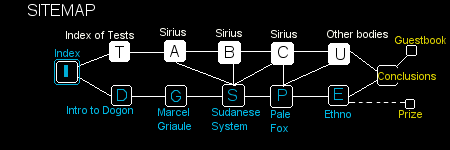Tests 2-3
Sirius
B is white.
Sirius
B is small but heavy.
[YES] to these two:
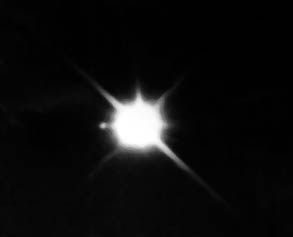 |
Sirius B is a White Dwarf. It is a
star roughly the size of the Earth, but with roughly the
mass of the Sun. Here is what the Harvard Bright Star
Catalog (available from CDS as a
Gzipped file, requiring Gunzip) has to say:
"B is first white dwarf ever discovered;
predicted by Bessel (1844) on basis of orbital motion of
Sirius, it was first seen by Alvan Clark in 1862, and its
peculiar high temperature, small size and great density
established by W. Adams in 1925."
(<-- First photo of Sirius A & B by Irving
Lindenblad 1973)
|
The first man to properly understand white dwarves was (Nobel
laureate and died only in 1995) Subramanyan Chandrasekhar in 1928.
Having a mass below what is now known as the Chandrasekhar Limit
(1.4 solar masses), Sirius B avoided collapse into a Neutron Star
or Black Hole; having used up its fuel, its gravitational
collapse has been balanced by the exclusion principle of its so-called
"degenerate electrons."
Our most recent numbers for the dimensions of Sirius B are
presented in
Sirius B: A New, More Accurate View
by J.B. Holberg, M.A. Barstow, F.C. Bruhweiler, A.M. Cruise and A.J.
Penny
Astrophysical Journal v.497, p.935 04/1998 (Another great find
from NASA
ADS)
Temperature, mass (Mo), radius (Ro) take
Holberg et al's figures without the ± margins for error. Data is
from Extreme Ultraviolet Explorer (EUVE), and reprocessing of
International Ultraviolet Explorer (IUE) data, and assuming the
star is a perfect sphere.
| Effective Temperature: (K) |
24,790 |
| Mass: (Mo) |
1.034 |
| Mass: (kg) |
2,056,626,000,000,000,000,000,000,000,000 |
| Radius: (Ro) |
0.0084 |
| Radius: (km) |
5838 |
| Volume: (m3) |
833,452,553,034,495,433,745 |
| Density: (kg/m3) |
2,467,598,176 |
| Density: (tonne/cm3) |
One heavy sugar cube at just
less than 2.5 tonnes!!! |
Un Systeme Soudanais de Sirius presents this
statement:
"It [Digitaria] is
composed of a metal named sagala, a little brighter than iron,
and of a weight that everyone on earth cannot lift it. The star
weighs 480 mule loads (about 35,000 kg), or all grains, or all
the iron on earth, if they were theoretically the size of a
stretched cow hide or a mortar board." -- p287
In actual fact, 35 tonnes of Sirius B occupy only 14cm3.
A mouse-hide perhaps...
Much more interesting is the Dogon concept of "Sagala,"
supposed to be shiny and metallic. It is a feat of tremendous
imagination to name and give physical properties to white-dwarf
material. Holberg and co. confirm that Sirius B is a "carbon
core" white dwarf; it is known that white dwarfs start out
hot and gradually cool to "black dwarfs". What is this
matter chemically -- carbon-diamondoid? Can white-dwarf material
separate from its "parent" and retain its integrity and
structure? Could this be cool and stable? Could this be handled (if
not picked up!)? Would it be reactive with normal matter, and if
so how?
Anyone who could give sensible answers to these questions was
eligible for a prize
***The first prize falls***. Ralph Temple writes:
"If a bit of the material that composes Sirius B were to be removed from its parent star, assuming a feasible method, the mass thus removed would find itself separated from the gravity field that not only created it but must remain to make it stable, and the properties of normal matter would reassert themselves in short order. Probably violently. And with force that accelerated at a rate proportional to the square of the distance removed from the center of the gravity well." Thanks Ralph. So no keeping any sagala in my back yard then :-(
Test 4
Sirius
B has an orbit of 50 years.
[YES, BUT...] Sirius B does not in fact orbit around Sirius A.
The two stars orbit around a common centre of mass. We see an
apparent orbit.
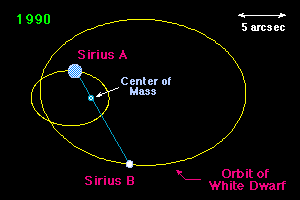
The most recent number for this orbit P (Benest &
Duvent 1995, see below) is 50.052 years.
Test 5
Sirius
B orbit is perpendicular to the horizon.
[NEARLY]
The angle of inclination i of Sirius B orbit is 136.62°
(Benest & Duvent 1995, see below)
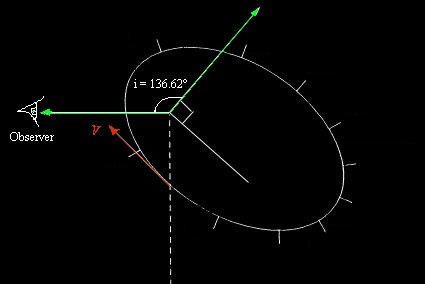
Taking the Dogon statement to mean i = 180°, then
they are only 44° short (less than half a right angle).
Test 6
Sirius
B has rotational period of one year.
Considered unmeasurable by most ordinary mortals, Temperature,
Radius, and Rotational Velocity of Sirius B by Peter Thejll
and Harry L Shipman, Astronomical Society of the Pacific 98-922-926
(1986) [another paper from the NASA ADS]
claims to derive the interrelationships between radius,
rotational velocity and effective temperature for Sirius B, and
gives a range of possible equatorial velocities for Sirius B from
0 to 600 km/s. The Dogon are still in there; a period of rotation
of one year, based on Holberg et al's radius of 0.0084 Ro
(see above), gives an equatorial velocity of 0.00116 km/s.
In 1986, it appears that Sirius B numbers for temperature, mass,
radius, etc, were in doubt. Harvard Bright Star Catalog gives an
effective temperature of 32,000K; Thejll and Shipman date this to
1971. They themselves are working with a temperature of 26,000-28,000K
from IUE and Voyager 2 data. However, using Thejll and Shipman's
handy little diagram with Holberg's 1998 data (see above), a
rather different picture emerges.
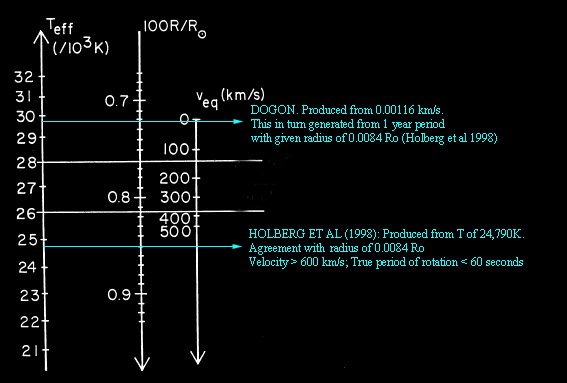
So [NO] it would appear that the Period of Rotation of Sirius B
is less than a minute rather than a year.
Test 7
Sirius
B spins and ejects matter.
[YES] Sirius B spins. See Test 6 above. And
[YES] it ejects matter. From an overabundance of iron and
titanium in Sirius A's atmosphere, HBSC admits that there is a
"possibility that the atmosphere of Sirius A [is] polluted
by material ejected from Sirius B"
A and B are reported to be emitting soft (weak) X-rays so are
probably not exchanging matter as a cataclysmic variable, but
there must be gravitational interaction and tidal effects.
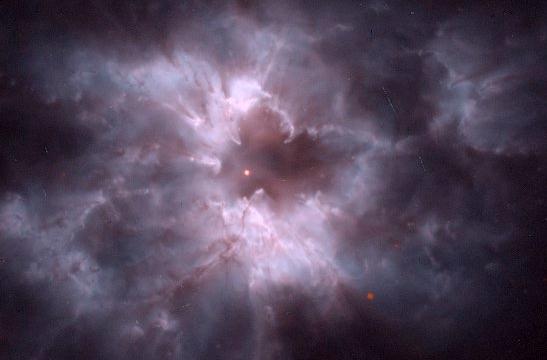 |
Picture shows a new, hot white dwarf star surrounded
by the remnants of its red-giant shell. |
There may have been a closer connection in a previous stage of
stellar evolution, matching with the Chinese observation of a
"horn" on Sirius as described in the paper by Bonnet-Bidaud
and Gry in test 1.
| In this artist's impression of a cataclysmic variable,
mass flows as a distended ejecta looking uncannily like a
placenta, a major feature of star formation described in Renard
Pale. |
 |
Test 8
Sirius
A scintillates at periastron and aposastron of Sirius B.
Any sensible answer to this strange assertion, unmatched by any
other culture or known observation will get a reward.
SCINTILLATION
Scintillation is the twinkling of stars (fluctuation of intensity)
seen through a planet's atmosphere. Scintillation in caused when
the star's light is distorted by the Earth's atmosphere.
Scintillation is greater for bright stars that are low on the
horizon. It is also known as astronomical scintillation. (ZoomSchool)
Test 9
Sirius B is remnant of first generation
star whose material formed others in the vicinity.
It is said that Sirius B age is about 1 Gyr. Any sensible
suggestions about how or not its matter may have formed nearby
stars is eligible for a prize.
NEW*** Correspondent Byron adds the following:
The Sun moves around the Milky Way in an elipse at 160 miles per/sec or once in about 240 million years. Although the stars near us move in the same direction and at approximately the same velocity, their proper motion, elipses vary from the Sun's. In other words, although Sirius is some 8 lys from us now, its distance from us varies depending on where we are in our path about the milky way. It is altogether possible that Sirius and the sun have been in close proximity to one another more than once in the 16 or 17 trips we have made around the Milky Way.
As a white dwarf, Sirius B, previously a sunlike star spent its fuel and became a red giant. Its outer atmosphere expanded and then broke away (in all probability in a bipolar shape resembling two placenta, ie twin births) as planetary nebula. The directions of travel, that is, the break away are depicted by the Dogon in symbolic form. That nebula could have been capture by our young sun and through accretion formed the earth or at least contributed to the formation of the earth. Incidently, our sun is considered a third generation sun because of its high calcium content.
and he adds,
Sirius is a hot, blue star, fairly young and it will burn out in
millions rather than billions of years. So, the wandering during the
billions of years was done by Sirius B, an old star. As for the distances
our sun and Sirius B have traveled around the galactic center in the past 4
1/2 billion years, at about 576,000 mph, some 550 to 600 parsecs or 1900 to
2000 light years distance, a long way. Sirius at only 8 light years, in
terms of billions of years, is spitting distance.
One last thing to firm up this idea, a quote from Carl Sagan in Intelligent
Life in the Universe written by I. S. Shklovskii and Carl Sagan, published
by Dell Publishing in 1968, pages 107 and 108:
"What is the origin of matter? .... Fifty years ago, this question would
have been scientifically meaningless. ... today, we think we understand the
processes involved."
"From spectroscopic observations of the Sun, it has become clear that our
Sun is not a first generation star, and probably not even a second
generation star--that is, many atoms which constitute the Sun have, in the
past, been in the insides of other stars, stars now long since decayed into
white dwarfs."
Another one of those strange coincidences...
Next
